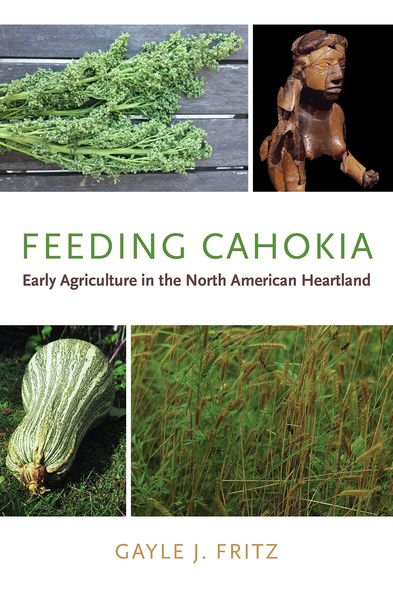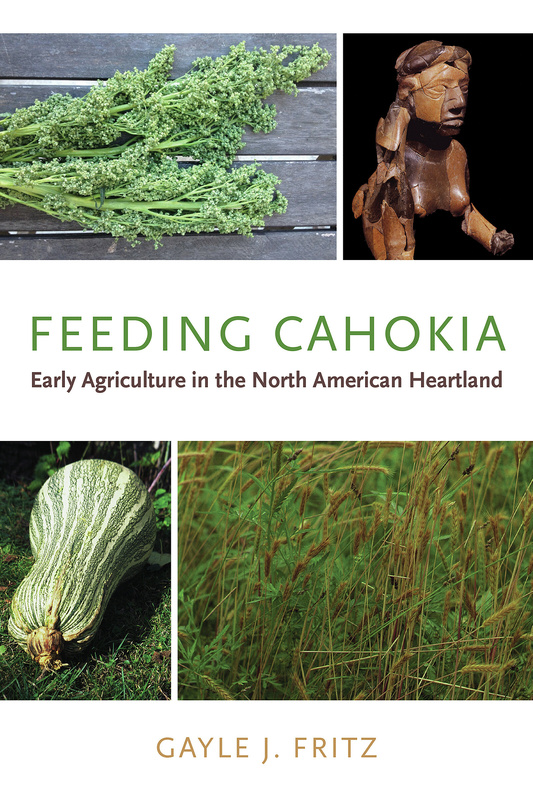
Feeding Cahokia
Early Agriculture in the North American Heartland
An authoritative and thoroughly accessible overview of farming and food practices at Cahokia
Agriculture is rightly emphasized as the center of the economy in most studies of Cahokian society, but the focus is often predominantly on corn. This farming economy is typically framed in terms of ruling elites living in mound centers who demanded tribute and a mass surplus to be hoarded or distributed as they saw fit. Farmers are cast as commoners who grew enough surplus corn to provide for the elites.
Feeding Cahokia: Early Agriculture in the North American Heartland presents evidence to demonstrate that the emphasis on corn has created a distorted picture of Cahokia’s agricultural practices. Farming at Cahokia was biologically diverse and, as such, less prone to risk than was maize-dominated agriculture. Gayle J. Fritz shows that the division between the so-called elites and commoners simplifies and misrepresents the statuses of farmers—a workforce consisting of adult women and their daughters who belonged to kin groups crosscutting all levels of the Cahokian social order. Many farmers had considerable influence and decision-making authority, and they were valued for their economic contributions, their skills, and their expertise in all matters relating to soils and crops. Fritz examines the possible roles played by farmers in the processes of producing and preparing food and in maintaining cosmological balance.
This highly accessible narrative by an internationally known paleoethnobotanist highlights the biologically diverse agricultural system by focusing on plants, such as erect knotweed, chenopod, and maygrass, which were domesticated in the midcontinent and grown by generations of farmers before Cahokia Mounds grew to be the largest Native American population center north of Mexico. Fritz also looks at traditional farming systems to apply strategies that would be helpful to modern agriculture, including reviving wild and weedy descendants of these lost crops for redomestication. With a wealth of detail on specific sites, traditional foods, artifacts such as famous figurines, and color photos of significant plants, Feeding Cahokia will satisfy both scholars and interested readers.
'Feeding Cahokia is an excellent summation of cultivated plant subsistence practices as evidenced by the material record from the interior Midwest. Because it is written in an accessible manner, it will appeal to anyone interested in the native cultivated crop complex; first in documenting its very existence and secondly for setting the record straight on its importance. As such, it is a good introduction to those topics for archaeologists wanting to understand and incorporate the archaeobotanical record into their research.'
—Midcontinental Journal of Archaeology
'This is an excellent book that examines a topic with deep roots in American archaeology: the role of agriculture in the rapid growth, florescence, and decline of Cahokia Mounds, the largest prehistoric population center north of Mexico. For years, the archaeological story maintained that Cahokia's ruling class governed via a wealth distribution system that relied mainly on corn grown by the lowest classes of society. Fritz sees this as a vastly oversimplified scenario that misrepresents the status of farmers, who were primarily women and girls of various socioeconomic levels. Further, the narrow focus on corn as the primary crop overlooks the abundant evidence that numerous other plants, including knotweed, chenopodium, and maygrass, were major contributors to the Cahokia diet. Twenty-two color plates add substantially to the text, and each chapter concludes with recipes for preparing the plants discussed. What fun! Highly recommended.' —CHOICE
'In Feeding Cahokia, Gayle Fritz has provided new data that leads to new insights about the role of domestic crops and the farmers who grew them in such abundance that they supported Cahokia's population. This readable volume brings together years of research and paints a new and enlightened picture of the United States' greatest ancient city.'
—American Archaeology
‘A significant contribution both to our understanding of food and farming among ancient American Indians and to our understanding of the largest American Indian polity north of Mexico.’
—C. Margaret Scarry, editor of Foraging and Farming in the Eastern Woodlands and coeditor of Rethinking Moundville and Its Hinterland
Feeding Cahokia is packed with information in a concise, readable format, and will serve as an excellent starting point for researchers interested in Midwestern archaeobotanical studies. The inclusion of a modern or historical recipe employing Eastern Complex crops at the end of most chapters is an unexpected bonus.’
—Journal of the Iowa Archaeological Society
‘This thorough and accessible, beautifully written contribution provides a data-driven account of the agricultural systems of Cahokia. Feeding Cahokia reminds us that our agricultural systems have changed in the past, and they will change again. This epic work raises the intriguing question: could some of the crops grown by the residents of Cahokia have a role to play in the future of agriculture in the American Heartland? Dr. Fritz’s book provides a deep historical description of agriculture in this region, and offers a sense of resilience and hope for future food systems.’
—Economic Botany
‘Here, for the first time, dozens of monographs and syntheses are marshaled to deal with the many topics and problems that have arisen over the timing and nature of the biologically diverse agricultural system unique to the central Mississippi Valley.’
—James A. Brown, coeditor of Archaic Hunters and Gatherers in the American Midwest
I highly recommend Feeding Cahokia for several reasons. First, histories of the native cultivated plants are wonderfully presented in a concise and readable narrative. Anyone interested in native plant cultivation will find this book enlightening. Second, Fritz offers new interpretations of how farming and farmers were part of Cahokian social and political structures—with an emphasis on the roles of women as the farmers—and an interesting alternative to understanding the role of elites in a socially stratified society. A fun addition to the book are the recipes involving the EAC crops. Several of these plants are beautifully illustrated or photographed, as are significant artifacts, such as the female figurines. The extensive list of references cited is a bonus to anyone interested in more details about specific study areas and sites.’
—American Antiquity
‘This book is a wonderful resource on plant cultivation in the American Bottom region. I highly recommend it for those interested in food production in eastern North America. Further, this book will be useful for activists in Indigenous food sovereignty, farmers interested in more sustainable agricultural practices, and archaeologists considering ways their research could contribute to policy change.’
—Canadian Journal of Archaeology
Contents
List of Illustrations
Acknowledgments
Introduction
Chapter 1. Domesticating Gourds and Forests
Chapter 2. Sunflower and Marshelder: Late Archaic Period Eastern Crops
Chapter 3. Rise of the Eastern Agricultural Complex: Terminal Late Archaic and Early Woodland Periods
Chapter 4. Seeds of Exchange: The Middle Woodland Period
Chapter 5. Good Late Woodland Farmers in the American Bottom
Chapter 6. Feasting at Early Cahokia
Chapter 7. Early Mississippian Plant Use
Chapter 8. Guardians of All Vegetation
Chapter 9. Crop Production: Estimates of Yields and Dietary Proportions
Chapter 10. How to Feed Cahokia: Cultivating Fields and Social Relationships
Chapter 11. The Farmers Vote with Their Feet
Chapter 12. What Can We Learn from the Past?
References Cited
Index
Plates follow page 000.




